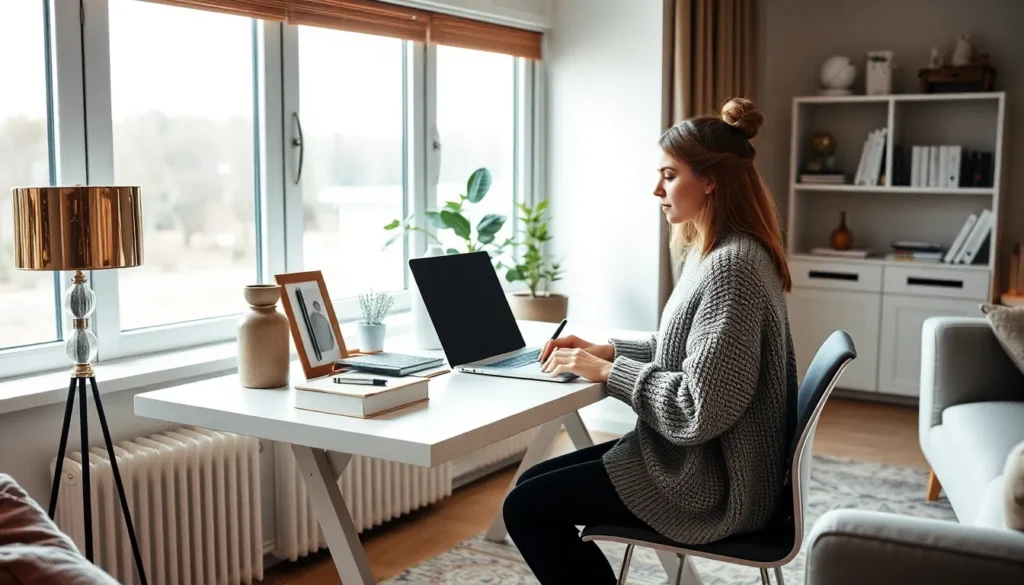Working from home has transformed how we view our living spaces. We’re no longer confined to traditional home offices when we need a productive workspace. The living room – often the heart of our homes – presents countless opportunities to create functional and stylish work areas that seamlessly blend with our existing décor.
Setting up a desk in your living room doesn’t mean sacrificing style for functionality. We’ve discovered that with the right approach you can create a workspace that enhances your room’s aesthetic while boosting your productivity. Whether you’re dealing with a compact apartment or a spacious family room the key lies in choosing answers that complement your lifestyle and design preferences.
From floating desks that maximize floor space to convertible furniture that serves double duty we’ll explore creative ways to integrate a workspace into your living area. These ideas will help you maintain the comfort and warmth of your living room while carving out the perfect spot to tackle your daily tasks.
Choose the Perfect Corner for Your Living Room Desk
Selecting the right location transforms your living room desk from an afterthought into a functional centerpiece. Strategic placement ensures your workspace enhances rather than disrupts your living area’s flow.
Identify Underutilized Spaces
Empty corners offer prime real estate for living room desk setups without sacrificing valuable floor space. We often overlook these areas, yet they provide natural boundaries that define your workspace while maintaining the room’s open feel.
Dead space behind sofas creates unexpected opportunities for narrow desk configurations. Built-in alcoves and nooks transform into productive zones with minimal furniture rearrangement. Bay windows present ideal spots for floating desk installations that capitalize on architectural features.
Awkward wall sections between doorways accommodate compact writing desks perfectly. Room transitions near hallways or staircases often contain unused square footage that works beautifully for small office areas. Wall spaces adjacent to entertainment centers can house sleek desk units that complement existing furniture.
Consider Natural Light Sources
Window placement determines desk positioning for optimal lighting throughout your workday. North-facing windows provide consistent, gentle illumination without harsh glare that strains your eyes during computer work.
East-facing locations capture energizing morning light that naturally boosts productivity levels. South-facing spots require careful positioning to avoid direct sunlight that creates screen reflection issues. West-facing areas work well for afternoon tasks but may need blinds for late-day comfort.
Corner windows create the most desirable lighting conditions by surrounding your workspace with natural brightness. Side lighting from adjacent windows reduces shadows on your work surface more effectively than overhead fixtures. Multiple light sources from different angles eliminate the need for supplemental desk lamps during daylight hours.
Evaluate Foot Traffic Patterns
High-traffic pathways through your living room determine where desk placement works best for daily functionality. We need to position workspaces away from main walking routes to maintain productivity and prevent constant interruptions.
Entrance routes from front doors create natural busy zones that interfere with concentrated work sessions. Kitchen access paths generate frequent movement that disrupts focus throughout meal preparation times. Bathroom corridors see regular foot traffic that makes nearby desk locations impractical for video calls.
Quiet zones near walls or in room corners typically experience minimal disruption from household activities. Protected areas behind furniture arrangements create natural barriers that shield your workspace from distractions. Spots with clear sightlines to entry points allow you to anticipate interruptions while maintaining work flow.
Create a Floating Desk Solution
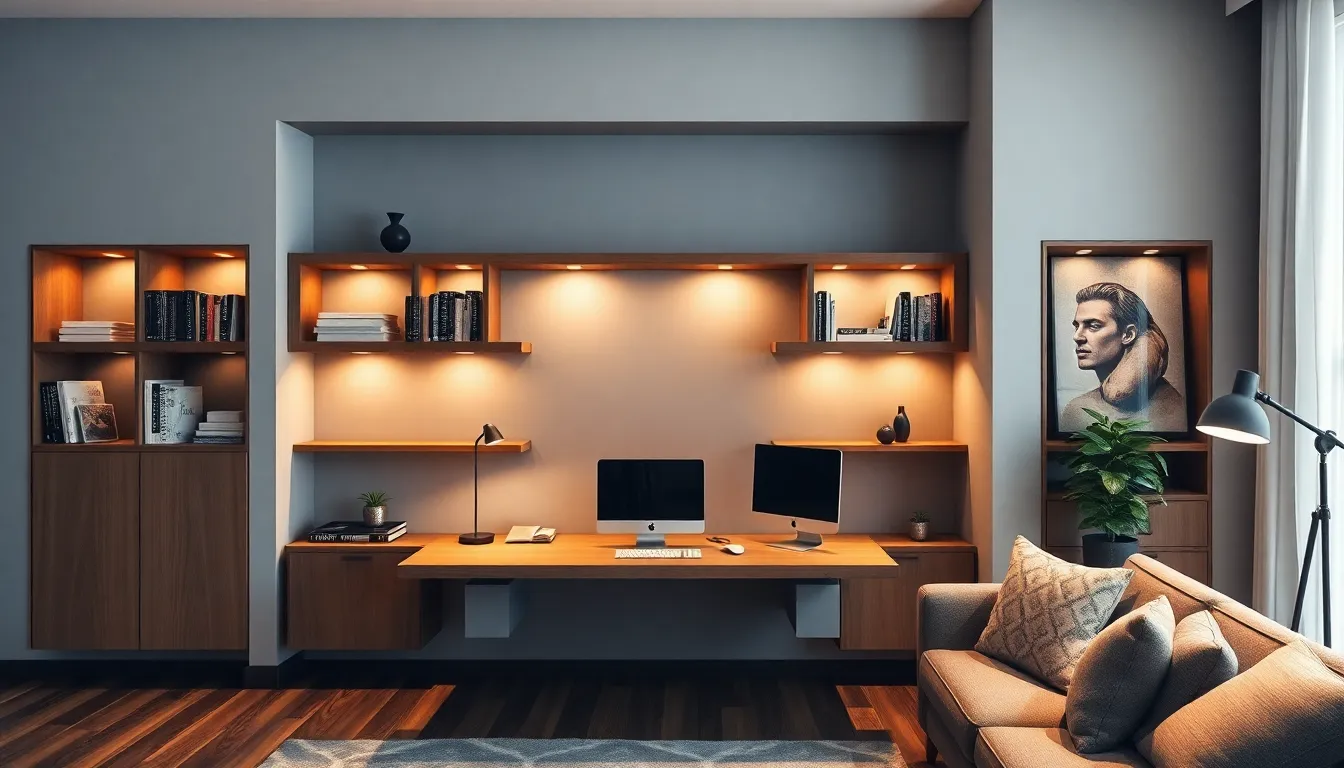
Floating desks transform any living room into a productive workspace while maintaining that essential aesthetic appeal we’re all seeking. We can create these answers virtually anywhere since they don’t require floor space, making them perfect for today’s compact living environments.
Wall-Mounted Desk Options
Wall-mounted desks offer incredible versatility for our living room workspace needs. We can customize these installations to match our room’s existing color palette, creating an almost invisible appearance when the desk isn’t in use. This seamless integration makes them particularly valuable for occasional home office tasks without disrupting our living space’s primary function.
These installations work exceptionally well for those of us who need flexibility in our workspace arrangements. We can position them at various heights to accommodate different users or activities, from standing desk configurations to traditional seated workstations.
Floating Corner Desks
Floating corner desks maximize those often overlooked spaces in our living rooms that typically go unused. We can transform dead corner areas into highly functional workstations without sacrificing valuable floor space for other furniture arrangements. These compact answers integrate naturally with our room’s existing layout while providing dedicated workspace that feels intentional rather than cramped.
Corner installations particularly benefit small living rooms where every square foot matters. We’re able to create productive zones that feel separate from our relaxation areas while maintaining the open flow that makes living spaces feel larger.
Built-In Shelving Combinations
Built-in shelving combinations create cohesive workspace answers that look like permanent architectural features. We can design these systems to store books, office supplies, and important paperwork while keeping our workspace organized and visually appealing. This integrated approach eliminates the cluttered appearance that standalone furniture often creates.
These comprehensive systems allow us to customize storage answers based on our exact needs. We can incorporate closed cabinets for hiding less attractive items while displaying books and decorative objects on open shelves, creating a workspace that serves both functional and aesthetic purposes in our living room environment.
Design a Multi-Functional Console Table Workspace
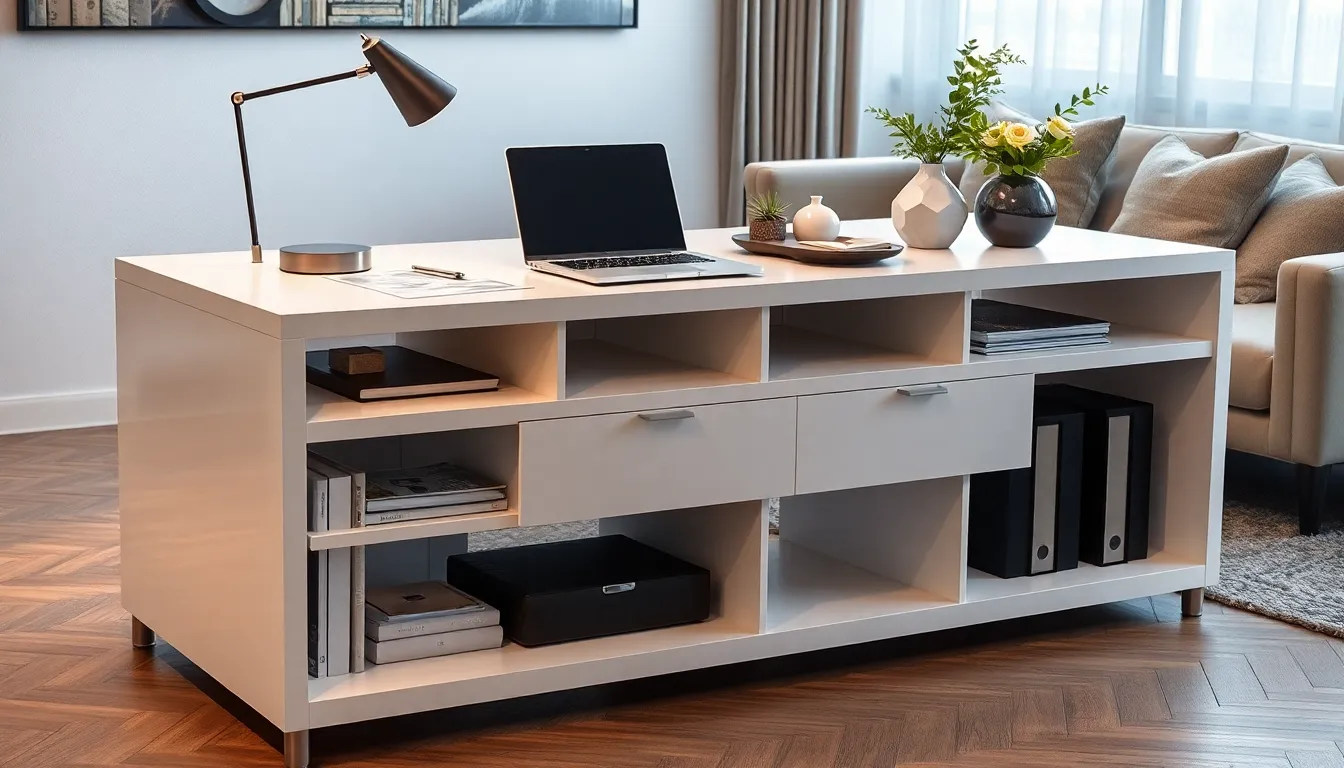
Console tables offer the perfect balance between form and function for living room workspaces. We’ve found that these versatile pieces can seamlessly transition from decorative furniture to productive work surfaces.
Console Tables with Hidden Storage
Hidden storage compartments transform ordinary console tables into organized workspace answers. Drawers beneath the surface keep office supplies, cables, and personal items completely out of sight while maintaining easy access during work sessions.
We recommend choosing console tables with multiple storage levels to maximize organization potential. Built-in drawers can house everything from notebooks and pens to charging cables and small electronics. Shelving compartments below the main surface provide additional space for books, binders, or decorative storage boxes.
Lift-top mechanisms add an ergonomic advantage to console table workspaces. These innovative designs allow you to raise the work surface to a more comfortable height for typing or writing. When closed, the console maintains its sleek profile and serves as a traditional display surface for decorative items.
Convertible Console to Desk Options
Folding desk extensions provide instant workspace expansion when needed. These clever designs feature panels that fold out from the main console body, creating a larger work surface for projects or multiple monitors. When work is complete, the extensions fold back seamlessly into the console structure.
Retractable desk mechanisms offer another space-saving solution for living room offices. Pull-out sections slide from within the console table, creating a temporary workspace that disappears completely when not in use. This design maintains the console’s decorative function while providing full desk capabilities on demand.
Drop-down desk surfaces maximize vertical space efficiency in console table designs. These panels fold down from the console’s front face, creating an instant writing surface or laptop station. The mechanism keeps the workspace hidden when closed, preserving the console’s clean aesthetic lines.
Behind-the-Sofa Desk Arrangements
Sofa-back console desks create productive zones without disrupting living room flow patterns. We position these narrow workspaces directly behind sectionals or sofas, utilizing otherwise wasted space for functional purposes. The console height typically aligns with sofa backs, creating a cohesive visual line across the room.
Floating shelves complement behind-the-sofa desk setups by providing vertical storage answers. Wall-mounted shelving above the console creates space for books, decorative objects, and office supplies while maintaining the open feel of the living area. These shelves can extend the full length of the sofa for maximum storage capacity.
Sliding desk mechanisms work exceptionally well in behind-the-sofa configurations. These systems allow the desk surface to slide out when needed and tuck back against the sofa when not in use. The flexibility prevents the workspace from interfering with seating arrangements while maintaining easy access for work sessions.
Incorporate a Compact Writing Desk
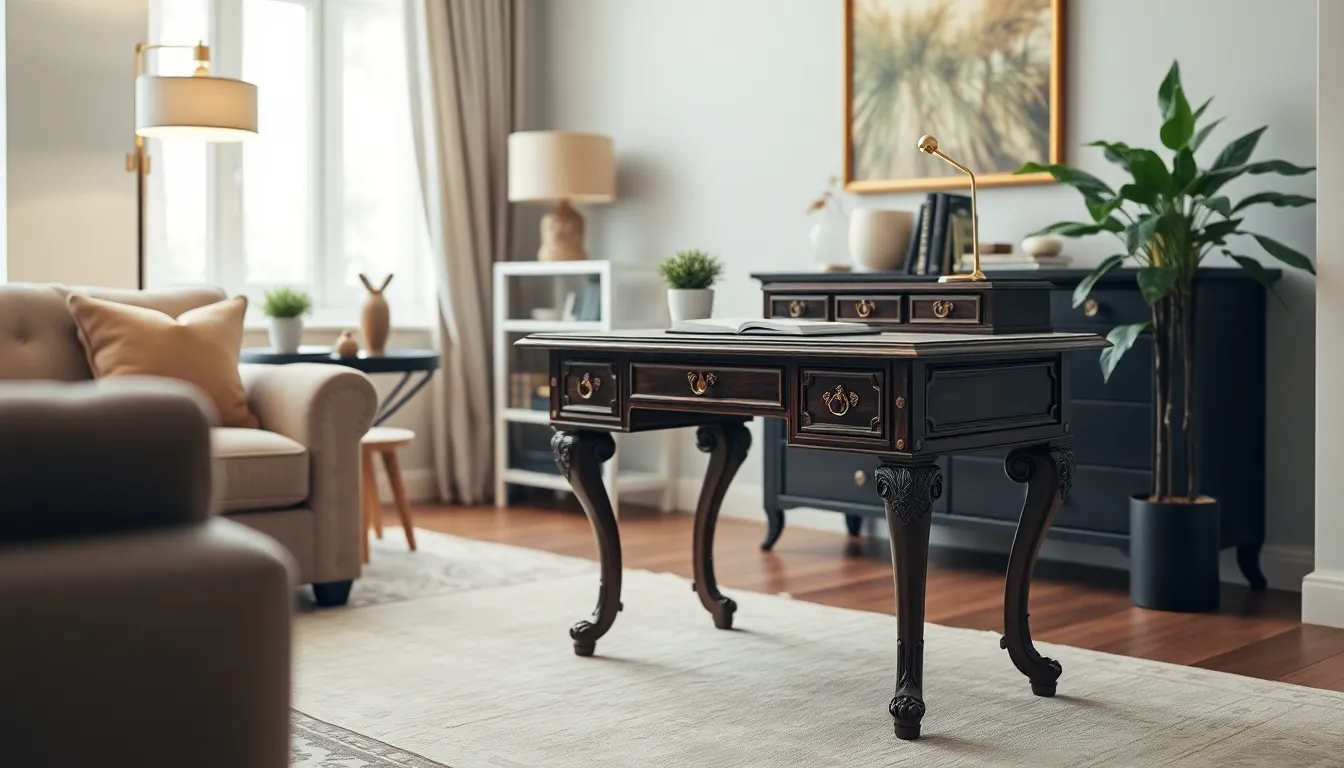
Compact writing desks offer the perfect solution for creating a functional workspace without overwhelming your living room’s design. We can seamlessly integrate these space-efficient pieces into corners or against walls to maximize functionality while maintaining the room’s natural flow.
Small-Scale Traditional Desks
Traditional desks with ornate details bring classic elegance to your living space while providing essential workspace functionality. We recommend selecting pieces with carved legs, brass hardware, and rich wood finishes that complement your existing furniture. These desks typically measure 36-42 inches in width, making them ideal for smaller living rooms where space efficiency matters.
Matching your traditional desk with complementary furniture creates a cohesive design aesthetic throughout the room. We suggest coordinating wood tones and decorative elements like similar brass accents or carved details. Placement near a window or bookshelf enhances the scholarly atmosphere these pieces naturally create.
Modern Minimalist Writing Tables
Clean-lined writing tables featuring glass tops or metal frames deliver contemporary sophistication to any living room setup. We prefer designs with simple geometric shapes and neutral colors that won’t compete with your room’s existing decor. These streamlined pieces often incorporate materials like tempered glass, brushed steel, or light-colored wood.
Sleek functionality defines modern minimalist desks through their uncluttered surfaces and integrated cable management systems. We can position these tables against walls or in corners where their simple profiles maintain the room’s open, airy feeling. Their understated design makes them virtually invisible when not in use.
Vintage Secretary Desk Styles
Secretary desks provide exceptional versatility through their fold-up design that conceals the workspace when not needed. We love how these classic pieces transform from decorative furniture into functional workstations within seconds. Their compact footprint makes them perfect for small living rooms where every square foot counts.
Positioning vintage secretary desks by windows or in quiet corners creates dedicated work zones with character and charm. We recommend styles with multiple compartments and cubbyholes that keep office supplies organized and easily accessible. Their timeless appeal adds unique visual interest while serving double duty as both storage and workspace.
Establish a Room Divider Desk Setup
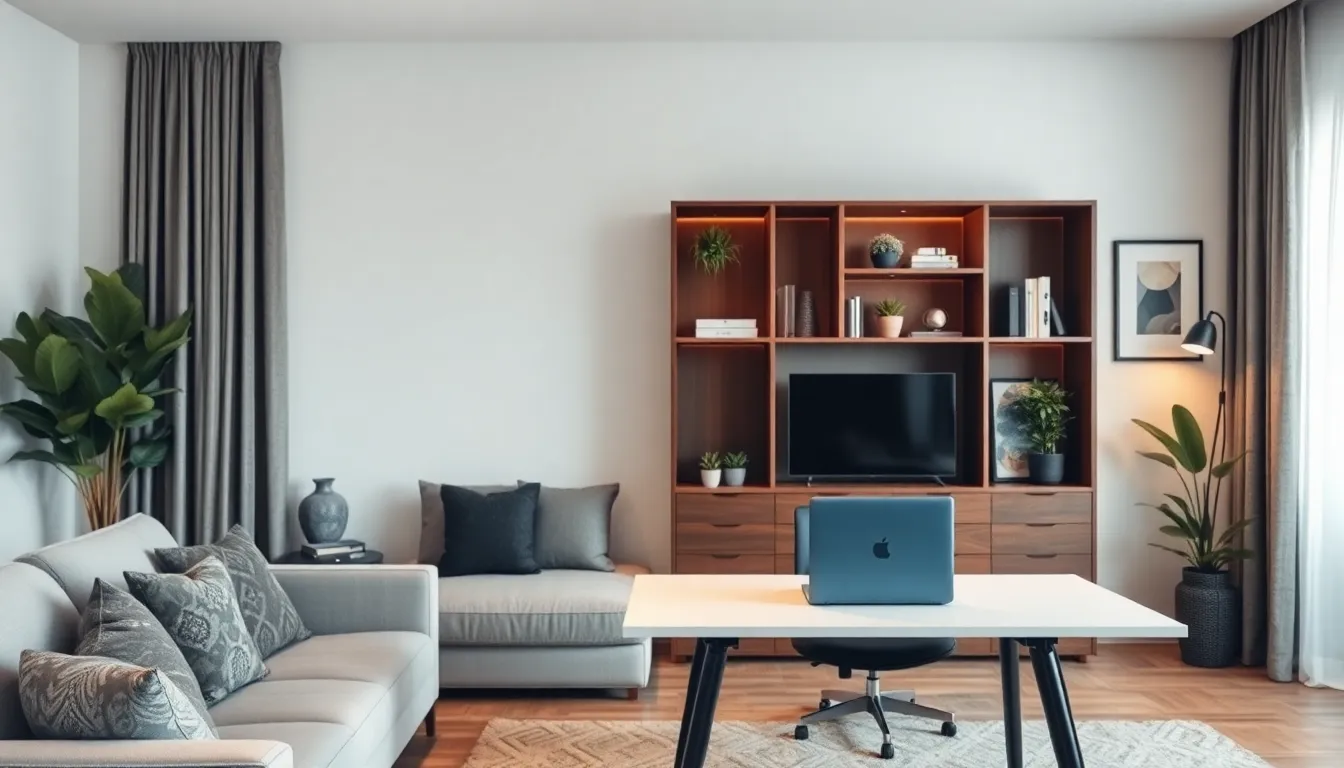
Creating physical boundaries between your workspace and relaxation areas can dramatically improve both productivity and the living room’s aesthetic flow. Room divider desk setups effectively separate your workspace from the rest of the living area while maintaining an open, connected feel.
Open Shelving Units with Desk Space
Open shelving units combined with desk space add functionality to a living room while maintaining visual transparency. These versatile combinations allow for storage of books, decorative items, and office supplies without creating visual barriers that make the space feel cramped.
Strategic placement of these units can define work zones while preserving the room’s open atmosphere. We recommend positioning them perpendicular to walls to create natural boundaries between living and working areas. Display decorative objects like plants, artwork, or books on higher shelves to maintain the living room’s aesthetic appeal.
Storage accessibility becomes effortless with open shelving desk combinations since frequently used items remain within arm’s reach. Consider units with varying shelf heights to accommodate different storage needs, from tall binders to small desk accessories.
Bookcase Desk Combinations
Bookcase desk combinations are a popular choice for living rooms because they provide ample storage for books and documents while doubling as a workspace. These integrated answers help maintain a clutter-free environment and blend seamlessly with the rest of the room’s decor.
Built-in bookcase desks create cohesive workspaces that eliminate the need for separate furniture pieces. We suggest choosing units with closed storage compartments at desk level to hide office supplies and maintain visual organization. Upper shelves can display books and decorative items that enhance the living room’s personality.
Modular bookcase desk systems offer flexibility for changing needs and room layouts. These systems typically feature adjustable shelving and removable desk components that adapt to different workspace requirements over time.
Freestanding Partition Workstations
Freestanding partition workstations offer flexibility and can be placed anywhere in the room without permanent installation. These mobile answers serve both as a desk and a partition, helping to define the workspace without being too intrusive or overwhelming the living room’s design.
Mobility advantages make freestanding workstations ideal for renters or homeowners who frequently rearrange their spaces. We recommend choosing units with wheels or lightweight construction for easy repositioning based on natural light changes or seasonal furniture arrangements.
Double-sided functionality maximizes the partition’s utility by providing work surface on one side and display or storage space on the other. Consider designs with integrated cable management to keep electronic devices organized and prevent cord clutter from disrupting the living room’s clean appearance.
Transform Your Window Area into a Desk Nook
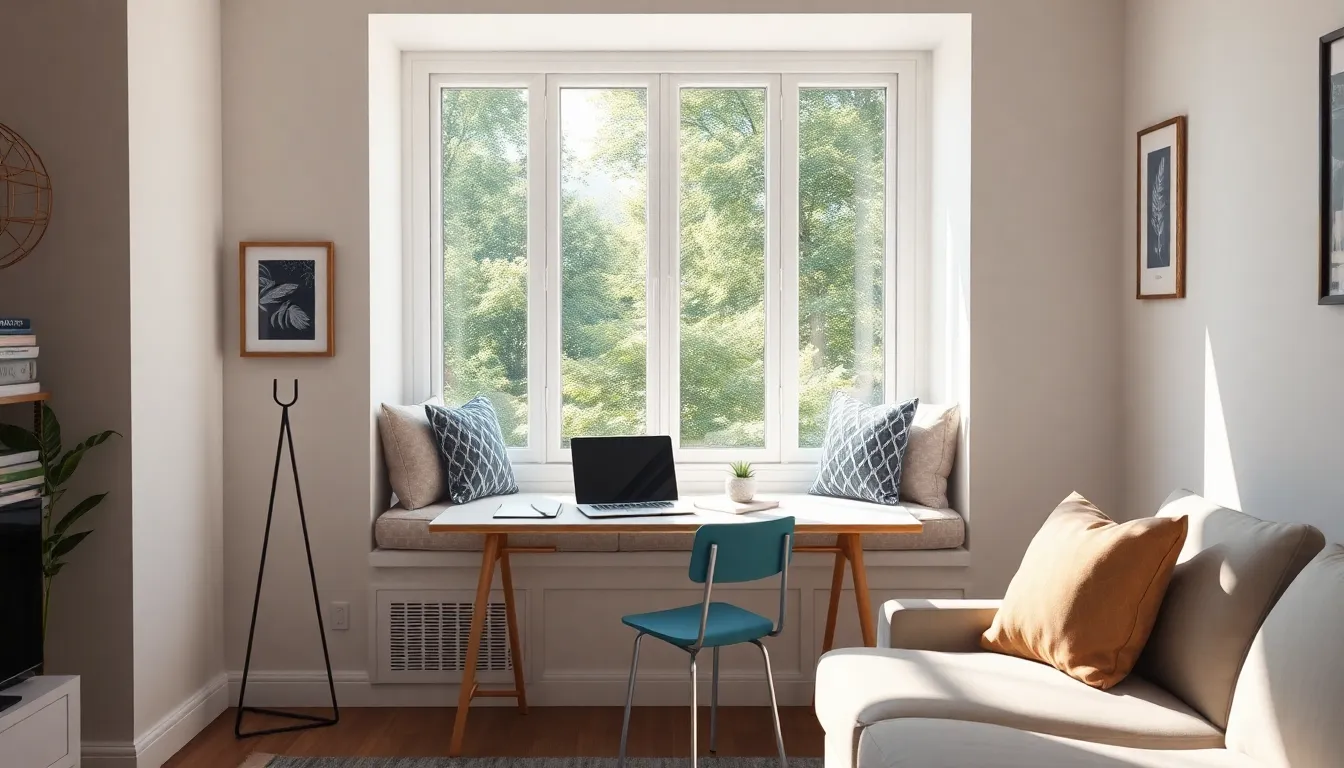
Windows offer some of the most underutilized space in our living rooms, yet they provide the perfect foundation for creating bright and inspiring workspaces. Natural light streaming through these areas can transform any desk setup into a productivity powerhouse while maintaining the room’s overall aesthetic.
Window Sill Extension Desks
Window Sill Extension Desks maximize the space directly beneath windows by creating a seamless work surface that extends from the existing sill. We can install a floating desk platform that spans the width of the window, essentially doubling the functionality of this often-wasted area.
Compact workspace answers work particularly well in smaller living rooms where every square foot counts. Installing a narrow desk shelf that’s 12-16 inches deep provides ample space for a laptop, notebook, and essential supplies without overwhelming the room’s proportions.
Natural lighting benefits make these setups ideal for tasks requiring visual clarity like reading, writing, or detailed computer work. Studies show that workers positioned near windows experience 15% better productivity compared to those in interior spaces.
Custom depth options allow us to tailor the desk size to our exact needs, with depths ranging from 10 inches for minimal laptop use to 24 inches for more comprehensive workstations. This flexibility ensures the desk doesn’t protrude too far into the living space.
Bay Window Workspace Ideas
Bay window workspaces create the most charming and functional desk nooks by utilizing the unique architectural features of these protruding window areas. The three-sided glass configuration provides panoramic views and abundant natural light from multiple angles.
Curved desk installations follow the natural contours of bay windows, creating a wraparound workspace that maximizes both surface area and the window’s architectural appeal. We can design these desks with built-in cable management and storage compartments underneath.
Reading nook combinations blend workspace functionality with cozy relaxation areas by incorporating a small desk alongside comfortable seating. Adding a cushioned window seat with lift-up storage creates a dual-purpose area perfect for both work and leisure.
Multiple monitor setups work exceptionally well in bay windows since the curved configuration naturally accommodates wide screen arrangements without creating glare issues. The varied angles help reduce eye strain during extended work sessions.
Under-Window Built-In Answers
Under-window built-in answers provide the most seamless integration between workspace and living room design by creating custom furniture that appears as part of the home’s original architecture. These installations can span single windows or connect multiple windows along one wall.
Integrated storage systems combine desk space with drawers, cabinets, and shelving units that maintain clean lines while hiding office clutter. We can incorporate file drawers, supply storage, and even printer compartments within the built-in design.
Matching room aesthetics becomes effortless when built-ins use the same materials, colors, and hardware as existing cabinetry or trim work. This coordination makes the workspace feel like a natural extension of the living room rather than an added afterthought.
Professional installation benefits ensure proper support for heavier equipment and create custom answers that maximize both function and visual appeal. Built-in desks can support weights up to 150 pounds when properly anchored and constructed with quality materials.
Integrate Technology-Friendly Desk Features

Modern living room workspaces require thoughtful integration of technology to maintain both functionality and aesthetic appeal. We’ll explore essential features that keep your devices organized and your workspace efficient.
Cable Management Answers
Organize cables effectively using cable management systems that hide unsightly cords from view. We recommend installing cable organizers beneath your desk surface to route power cords, USB cables, and charging cables through designated channels. Adhesive cable clips attach directly to desk edges and keep frequently used cables within easy reach while preventing them from falling to the floor.
Route cables through desk grommets for a clean, professional appearance that complements your living room’s design. Desk grommets come in various sizes and finishes, allowing you to match your existing hardware while providing easy access for device connections. Cable ties bundle multiple cords together, creating organized pathways that remain hidden behind your desk or along baseboards.
Install under-desk cable trays to completely conceal power strips and excess cable length. These trays mount directly beneath your work surface and provide a dedicated space for power management without cluttering your floor space. Cable spine protectors can also run along walls to guide cables from your desk to nearby outlets while maintaining your room’s clean aesthetic.
Charging Station Integration
Build charging capabilities directly into your desk design with integrated USB hubs and power outlets. We suggest selecting desks with built-in charging stations that accommodate multiple devices simultaneously, eliminating the need for bulky adapters on your work surface. Desktop charging stations with wireless charging pads provide convenient power access for smartphones and compatible devices.
Position charging stations strategically to keep devices accessible while maintaining workspace organization. Drawer-mounted charging stations hide cables and adapters while keeping devices secure and dust-free. Multi-port USB hubs with individual power switches allow you to control device charging and reduce standby power consumption.
Consider modular charging answers that adapt to your changing technology needs. Magnetic charging stations attach to metal desk surfaces and can be repositioned as needed. Power strips with USB-C and traditional USB ports ensure compatibility with current and future devices while minimizing adapter requirements.
Ergonomic Monitor Placement
Position monitors at eye level to reduce neck strain and maintain proper posture during extended work sessions. We recommend adjustable monitor arms that clamp to your desk edge, providing height and angle adjustments without consuming valuable desk surface area. Dual monitor setups benefit from matching monitor heights and slight inward angles to create a comfortable viewing experience.
Maintain proper viewing distance by positioning monitors 20 to 26 inches from your eyes. Monitor stands with built-in storage compartments elevate screens to appropriate heights while providing space for keyboards, office supplies, or decorative items. Articulating monitor mounts allow you to adjust screen position throughout the day, accommodating different tasks and reducing eye fatigue.
Optimize screen positioning relative to natural light sources to minimize glare and eye strain. Monitors placed perpendicular to windows reduce reflections while taking advantage of ambient lighting. Anti-glare screen protectors provide additional comfort when monitor repositioning isn’t possible due to space constraints or furniture arrangements.
Style Your Living Room Desk for Seamless Decor
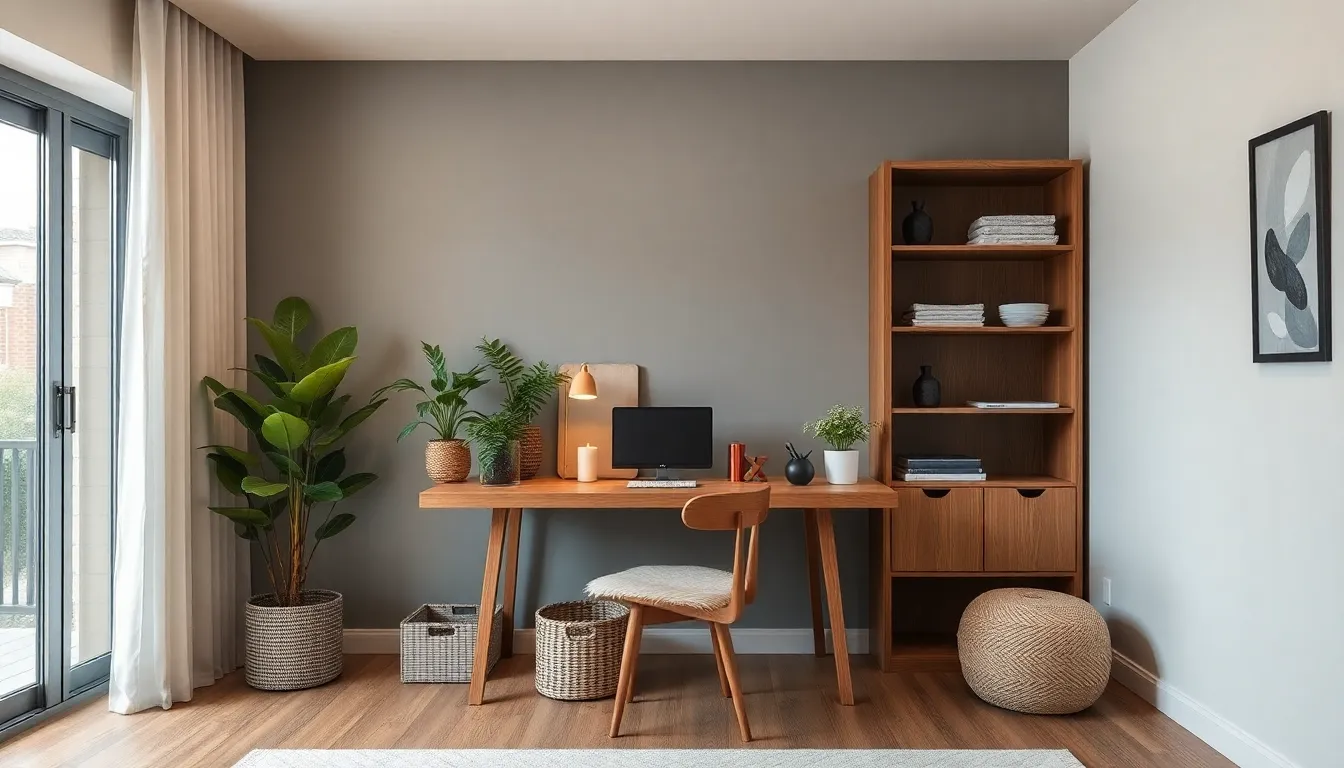
Creating a workspace that feels intentional rather than intrusive requires thoughtful styling choices. We’ll show you how to make your desk area blend beautifully with your existing living room aesthetic.
Color Coordination Strategies
Match wood tones throughout your space to create visual harmony that flows naturally from room to room. Light wood floating desks paired with matching shelves establish a cohesive foundation that reflects light and opens up the area. Bold colored desks or chairs inject personality while creating focal points that draw attention without overwhelming the space.
Neutral backgrounds provide the perfect canvas for workspace integration, allowing your desk to disappear into the room’s existing palette. Secretary desks in vintage style wood complement warm room tones while maintaining sophisticated functionality. Wall mounted desks benefit from neutral surroundings that let the workspace feel like a natural extension of your living area rather than an office addition.
Strategic color placement helps define your work zone without creating harsh boundaries between spaces. We recommend using one or two accent colors that already appear elsewhere in your living room to tie the workspace into your overall design scheme.
Decorative Storage Answers
Open shelving systems maximize vertical space while keeping essential items within arm’s reach of your workspace. Floating shelves positioned above wall mounted desks create additional storage without adding visual weight to smaller rooms. Compact task desks pair perfectly with minimal width surfaces that complement open shelving arrangements.
Hidden storage compartments maintain clean lines while concealing office supplies and paperwork that might disrupt your living room’s aesthetic. Built in answers offer seamless integration that appears custom designed for your exact space requirements.
Baskets and decorative containers provide flexible storage options that can easily transition from office organization to living room decor. We suggest choosing materials and colors that complement your existing furniture to maintain design consistency throughout the space.
Personal Touches and Accessories
Gallery walls create balanced visual interest when artwork frames echo the colors found in your shelves and surrounding furniture. Curated collections of framed prints and photos transform your desk area into a personalized design feature rather than a purely functional workspace.
Decorative objects add personality without creating office like formality that might feel out of place in your living environment. Secretary desks styled with lamps, prints, and carefully chosen accessories blur the line between workspace and living space when not actively in use.
Layered lighting options enhance both functionality and ambiance, allowing your desk area to serve multiple purposes throughout the day. Table lamps, wall sconces, or pendant lights can highlight your workspace while contributing to your living room’s overall lighting scheme.
Maximize Storage in Small Living Room Desk Areas

Smart storage answers transform cramped living room workspaces into organized productivity zones. Maximizing every inch becomes essential when we’re working with limited square footage.
Vertical Storage Answers
Wall mounted shelves use unused vertical space while keeping your desk surface clear for daily tasks. Installing floating shelves above the desk creates dedicated zones for books, files, and office supplies without adding visual weight to the room. Vertical file organizers attached to walls or door backs store important documents and papers in an easily accessible format.
Corner shelving units maximize those awkward angles that often go unused in small living rooms. Mounting narrow shelves from floor to ceiling creates impressive storage capacity for everything from reference books to decorative storage boxes. Tower style organizers positioned beside the desk provide multiple compartments for different types of supplies while maintaining a compact footprint.
Multi-Level Desk Organizers
Tiered desk organizers create separate zones for different office supplies on your work surface. Stackable trays allow us to customize the height and configuration based on our exact storage needs. Multi level systems keep frequently used items like pens, sticky notes, and paper clips within easy reach while maintaining a tidy appearance.
Desktop hutches add valuable storage space directly above the work surface without requiring wall mounting. Compartmentalized organizers with varying sized sections accommodate everything from small office supplies to larger items like notebooks and folders. Rotating desk caddies provide 360 degree access to supplies while taking up minimal space on the desktop.
Under desk storage answers use the often overlooked space beneath the work surface. Stackable containers slide easily under the desk to store less frequently used items like extra paper, seasonal supplies, or backup equipment. Rolling carts fit perfectly under most desks and can be pulled out when additional supplies are needed.
Hidden Storage Compartments
Storage ottomans serve double duty as comfortable seating and concealed storage for blankets, office supplies, or electronic accessories. These versatile pieces can be positioned near the desk area to provide extra seating for guests while keeping clutter hidden from view. Lift top designs make accessing stored items quick and convenient during busy workdays.
Hollow decorative items incorporate storage functionality into existing decor elements throughout the living room. Decorative boxes and containers blend seamlessly with your interior design while providing discrete storage for small items like remote controls, charging cables, or office accessories. False bottom drawers in existing furniture create secret compartments for valuable or sensitive documents.
Built in desk designs with integrated storage compartments maximize every inch of available space. Custom answers can include hidden drawers, pull out keyboard trays, and concealed cable management systems. Secretary desks with fold up surfaces provide complete workspace concealment when not in use, making them ideal for maintaining a clean living room aesthetic.
Balance Work and Relaxation Zones
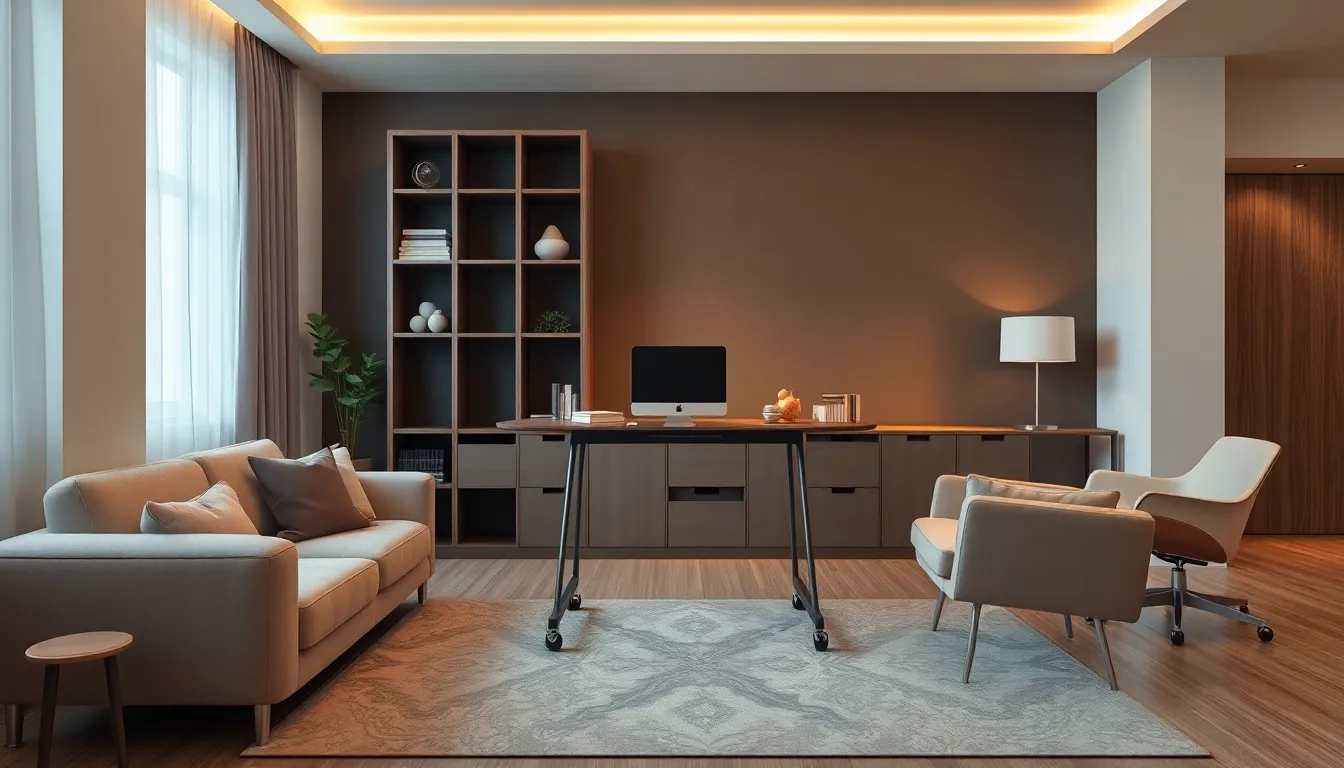
Creating a harmonious living room workspace requires thoughtful planning to ensure both productivity and comfort coexist. We’ll explore proven strategies that help define clear boundaries while maintaining the room’s dual functionality.
Visual Separation Techniques
Shelving units act as natural room dividers without blocking light or creating a closed-off feeling. We recommend positioning tall bookcases or open shelving between your desk area and seating zone to create distinct spaces while maintaining visual flow.
Contrasting color schemes help differentiate work areas from relaxation zones through strategic paint choices or accent walls. Paint the wall behind your desk in a deeper shade or add colorful artwork that signals the transition between spaces.
Area rugs define separate zones by anchoring furniture groupings and creating visual boundaries on the floor. Place a smaller rug under your desk chair and a larger one beneath the sofa to establish clear territorial divisions.
Lighting variations create mood distinctions between work and leisure areas through different fixture types. Install focused task lighting over your desk while using ambient floor lamps or table lamps in seating areas to signal different activities.
Flexible Furniture Arrangements
Compact desks with wheels or lightweight construction allow for easy repositioning based on daily needs. We suggest choosing desks under 48 inches wide that can roll behind sofas or into corners when entertaining guests.
Wall-mounted options fold down when needed and disappear against the wall during leisure time. Secretary desks with fold-up fronts provide full workspace functionality while transforming into decorative wall pieces after hours.
Swivel chairs on casters enable quick transitions between work tasks and social conversations without moving heavy furniture. Select chairs that complement your living room’s style while offering ergonomic support for extended work sessions.
Modular storage answers adapt to changing needs through stackable cubes, rolling carts, and adjustable shelving systems. These pieces can serve as desk storage during work hours and display areas for decorative items during relaxation time.
Transition Between Work and Leisure
Multi-functional furniture serves double duty by transforming from workspace to entertainment center throughout the day. Console tables with lift-top mechanisms function as desks during work hours and return to decorative display pieces for evening activities.
Built-in storage compartments keep work essentials completely hidden when transitioning to leisure mode. Desks with drawers or cabinets allow you to quickly stow away computers, papers, and office supplies behind closed doors.
Adjustable lighting systems signal the shift between work and relaxation through dimmable fixtures and multiple light sources. Task lamps provide focused illumination for productivity while ambient lighting creates a cozy atmosphere for unwinding.
Cable management answers maintain clean aesthetics by hiding work-related technology when it’s not in use. Under-desk trays and cord organizers ensure that cables and chargers don’t interfere with the living room’s relaxed atmosphere during off hours.
Conclusion
Creating a functional workspace in your living room doesn’t require sacrificing style or comfort. We’ve shown you that the right desk solution can enhance both productivity and aesthetic appeal while maintaining the room’s natural flow.
From floating desks to convertible console tables these versatile options prove that work and relaxation can coexist beautifully. The key lies in choosing answers that complement your existing decor while maximizing every square inch of available space.
Remember that effective cable management proper lighting and thoughtful storage will elevate your living room desk from functional necessity to design statement. With these strategies you’ll create a workspace that seamlessly transitions from productivity hub to stylish living area throughout your day.
Frequently Asked Questions
Can I set up a functional workspace in my living room without compromising style?
Yes, absolutely! Modern workspace solutions like floating desks, convertible furniture, and multi-functional console tables allow you to create productive work areas while maintaining your living room’s aesthetic appeal. The key is choosing pieces that complement your existing decor and serve dual purposes.
Where is the best location to place a desk in my living room?
The ideal location depends on natural light and foot traffic patterns. Areas near windows provide excellent lighting, while underutilized spaces like empty corners or behind sofas maximize floor space. Avoid high-traffic zones to minimize disruptions and maintain productivity throughout your workday.
What are floating desks and how do they work in living rooms?
Floating desks are wall-mounted workspace solutions that don’t require floor support. They’re highly customizable, can be positioned at various heights, and work particularly well in corners to maximize underutilized space. They create functional workstations while maintaining a clean, minimalist aesthetic.
How can console tables work as home office solutions?
Multi-functional console tables balance form and function perfectly. Look for designs with hidden storage compartments, lift-top mechanisms for ergonomic height adjustment, and multiple storage levels. Many feature convertible options like folding extensions that provide workspace when needed without compromising decorative appeal.
What storage solutions work best for small living room desk areas?
Maximize vertical space with wall-mounted shelves, under-desk organizers, and tiered desk accessories. Corner shelving units, hidden storage compartments in furniture, and built-in designs with integrated storage help keep office supplies organized while maintaining a clean, uncluttered appearance in compact spaces.
How do I separate work and relaxation zones in my living room?
Use visual separation techniques like room divider desk setups, contrasting color schemes, and area rugs to define distinct zones. Flexible furniture on wheels, adjustable lighting, and multi-functional pieces help create clear boundaries while maintaining the room’s cohesive flow and allowing easy transitions.
What technology features should I consider for my living room workspace?
Focus on cable management solutions like under-desk trays and grommets to keep cords organized. Built-in charging stations, USB hubs, and ergonomic monitor placement with adjustable arms are essential. These features maintain a clean appearance while ensuring your workspace is fully functional and professional.
How do I style my living room desk to match existing decor?
Coordinate colors by matching wood tones and using neutral backgrounds for visual harmony. Incorporate decorative storage solutions, personal touches like gallery walls, and layered lighting options. Choose desk accessories and organizational tools that complement your living room’s overall design aesthetic and color palette.

